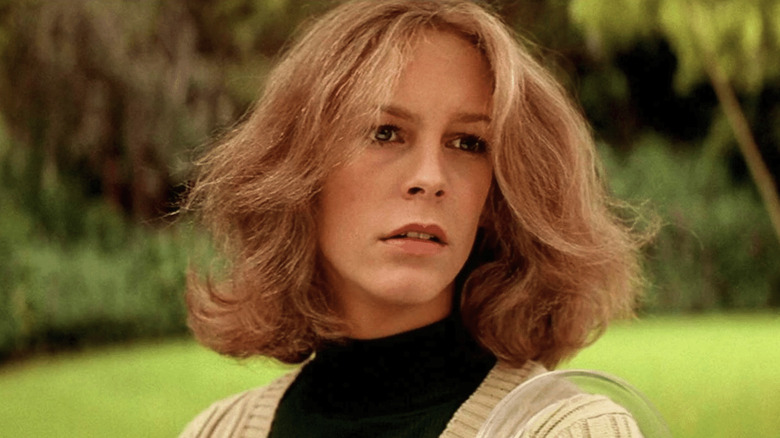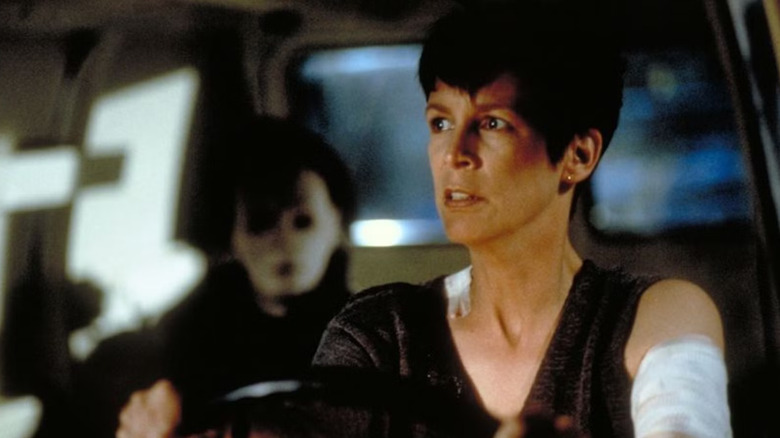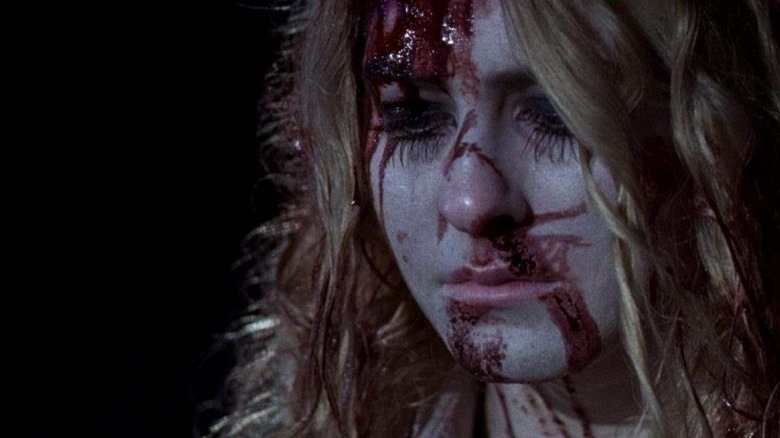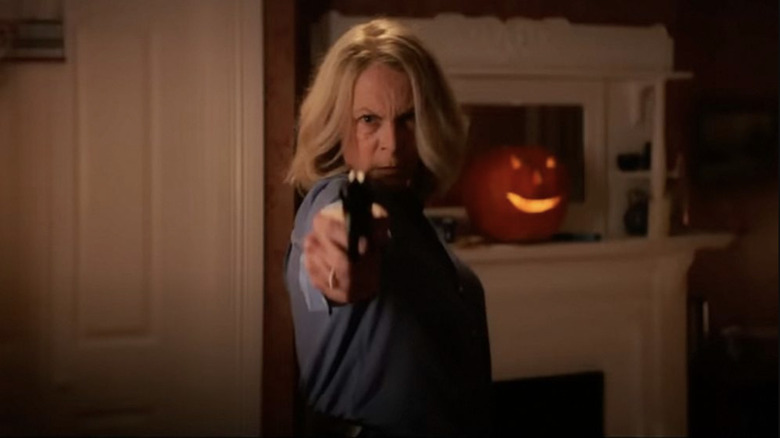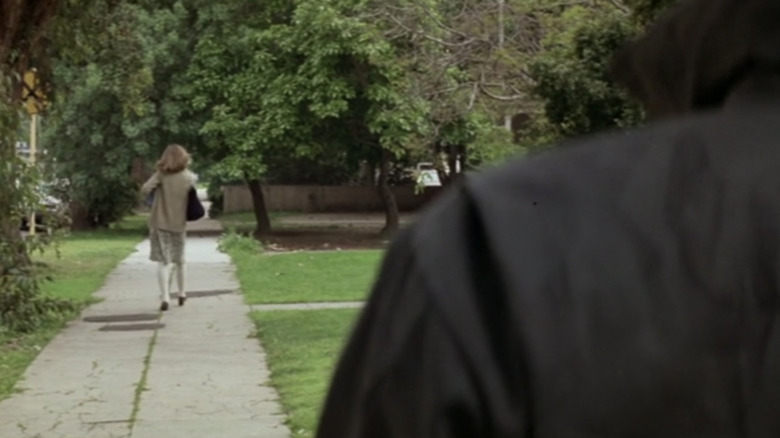Halloween: Is Laurie Strode The Sister Of Michael Myers?
In hindsight, 1978's "Halloween" was always destined to have a sequel. Co-writer/director John Carpenter and co-writer/producer Debra Hill even included a particularly prophetic line of dialogue in their tale of a supernaturally-charged maniac, Michael Myers, terrorizing his hometown on Halloween night: "You can't kill the bogeyman." Thanks to the film's massive success critically, commercially, and culturally, "Halloween II" was practically a given.
While "Halloween" concludes with the assertion that Myers has indeed not yet been killed, a trickier question for Carpenter and Hill concerned what to do with the other surviving supporting characters. Dr. Sam Loomis (Donald Pleasance) was established as the Van Helsing to Myers' Dracula, so his return was fairly natural. A bigger issue revolved around bringing back star Jamie Lee Curtis as Laurie Strode, the babysitter who unfortunately crosses Myers' path and becomes the focus of his All Hallows' Eve rampage. Not wanting to kill the character off and lose Curtis as her star in Hollywood was rising, but also not wishing to throw in contrivance after coincidence to explain why Myers kept pursuing one girl in particular, Carpenter famously decided to retroactively make Laurie Michael's secret sister.
That one (allegedly drunken) decision led to much of the rest of the "Halloween" franchise's lore, leaving the other 12 sequels/remakes/reboot films that followed having to choose whether or not Laurie and Michael had a blood connection as well as what that connection meant. Thus, the answer to whether or not Laurie Strode is the sister of Michael Myers isn't a simple "yes" or "no," but an ambiguous "eh, it depends." What follows is your handy guide to the Myers family tree, at least so you'll know where the Evil lies tonight!
From Halloween II to Halloween: Resurrection, Laurie Strode is Michael Myers' Sister
For the majority of the "Halloween" franchise, Laurie Strode is indeed Michael Myers' sister, as the two are regarded to be blood-related from the second installment, 1981's "Halloween II," through to the eighth, 2002's "Halloween Resurrection" (it should be made clear now that 1982's "Halloween III: Season of the Witch" is a standalone sequel out of continuity with the Michael Myers films). During this run of films, however, Laurie only appears in three installments. "Halloween 4: The Return of Michael Myers," "Halloween 5: The Revenge of Michael Myers," and "Halloween: The Curse of Michael Myers" feature Michael chasing after Jamie Lloyd (Danielle Harris in "4" and "5"; J.C. Brandy in "Curse"), who is Laurie's daughter that the Carruthers family adopt after Laurie has supposedly died in a car accident.
Jamie served a dual purpose in "Halloween 4," giving a revived Michael a new familial target to return to Haddonfield for and potentially spinning off the series in a new direction with young Jamie seemingly inheriting her uncle's Evil (more on that in a bit). When that new direction was abandoned in favor of Michael himself coming back over and over, Jamie remained in the role of a moving target for the slasher and was herself replaced in "Curse" musical-chairs style by having her own baby (who may or may not have been conceived by Michael — don't ask) that becomes adopted by the youngest biological daughter of the Strode family, Kara (Marianne Hagan), Laurie's cousin.
With "Halloween: H20," the series either splits continuity for the first time (well, second, counting "Halloween III") by following up directly from "Halloween II," or, if you squint, it has Michael literally pivot from continuing to pursue a now-deceased Dr. Loomis and the Lloyd bloodline with the discovery that Laurie faked her death and has been living in hiding in California with her now-teenage son. After the fateful rematch between estranged brother and sister ends tragically for Laurie, the woman loses the years-long struggle with the Evil she's related to. Michael claims her life and then goes back to his abandoned home in Haddonfield to cut up some college kids shooting a livestream show (the less said about "Resurrection," the better).
In Rob Zombie's Halloween and Halloween II, Laurie Strode and Michael Myers are related in more ways than one
When Rob Zombie was tapped to write and direct a remake of the original "Halloween" in 2007, he could've gone in any number of directions with the franchise and its characters. While some say he went too far and others say he didn't stray far enough from Carpenter's film, Zombie chose to remain very faithful to the letter of the series' mythos by not only including Laurie Strode (Scout Taylor-Compton, the only other actress besides Curtis to play the character) but making her relationship to Michael Myers (Tyler Mane) deeper than her just being his biological sister. Where the original "Halloween" timeline featured Michael pursuing Laurie out of some evil impulse the Shape had to destroy his family, Zombie's "Halloween" has Michael look for Laurie as part of his own twisted desire to bring his idealized family back together. Zombie attempts to chronicle Michael's insanity in "Halloween" and "Halloween II," depicting his psychosis as something that allows him to perceive the world in a completely different, surreal fashion than others.
In Zombie's "Halloween II," this insanity is revealed to be hereditary, as Laurie finds herself succumbing to the same psychosis that her brother suffers from, thanks to her traumatic experiences in the first film triggering it. On paper, that may sound like Zombie makes the ambiguous Evil of Carpenter and Hill's concept too literal. It also feels like Zombie picking up that dropped plotline involving Jamie's inheritance of Evil from "Halloween 4." Yet Michael and Laurie's seduction by rage in Zombie's films is depicted as something more supernatural here, a force that they've tapped into, as both Michael and Laurie suffer from visions involving a white horse (which may or may not be the Pale Horse of Biblical renown). In any case, the connection between Laurie and Michael is at its strongest in Zombie's two films. Where Laurie-as-sister in the original continuity is someone Good in metaphysical opposition to Michael's Evil, Laurie and Michael in Zombie's films are parts of a whole, people doomed by their blood to a dark destiny.
For David Gordon Green's Halloween trilogy, Laurie Strode and Michael Myers are not siblings
As I said earlier, John Carpenter was not a fan of making Laurie and Michael literally related to each other, so when David Gordon Green was handed the reins to the franchise in 2018, he decided to follow Carpenter's suggestion and de-couple Laurie and Michael by resetting the continuity all the way back to the original film. Even though this means that the rest of the series is no longer canon for "Halloween" 2018, "Halloween Kills," and "Halloween Ends," it doesn't necessarily mean that Laurie and Michael have no connection at all. A main theme of "Halloween" 2018 involves a group of characters who insist — either from the universe or from Michael (James Jude Courtney) himself — on an explanation for Myers' actions. The most demented of these people, Myers' new doctor Sartain (Haluk Bilginer), arranges for Michael's escape from custody in order to prove his theory that Michael and Laurie (Curtis, back in the role one last time) do in fact share some type of primal, hunter and prey relationship.
Being "Halloween," Sartain's hypothesis is inconclusive; one could still explain away Michael's pursuit of Laurie as a random chance. Yet Green and his collaborators make their "Halloween" trilogy a thematic summation of the franchise to date, exploring the potential origins of good and evil, their recurrence, and their relationship to one another via the people living on the battlefield of Haddonfield. Laurie and Michael therefore do share a relationship, even though it's not literalized through their blood. There's a sense that, just as Michael represents all things Evil, Laurie and her family represent Good, and the two elemental forces are destined to battle for dominance of the soul, whether it's the soul of a town or a person. Getting rid of Laurie's sisterhood to Michael only makes this allusion cleaner and stronger, and it's for that reason that it's best left out of Green's trilogy.
In John Carpenter's original Halloween, Laurie and Michael's relationship is up to you
Most interestingly, all of these changing relationships between Michael and his prey make the original 1978 "Halloween" more ambiguous, not less. Where a majority of horror sequels retroactively explain away too much about the monster's origins and motivations, "Halloween" continues to be shrouded in mystery thanks to the "choose your own adventure" nature of the sequels' shifting continuity. Thus, one can watch "Halloween" with the belief that Michael escapes Smith's Grove Sanitarium once his secret sister Laurie is the same age that his sister Judith (Sandy Johnson) was when he killed her as a boy. This mindset makes Michael's stalking of Laurie and her friends much more pointed, with the Shape following his deadly destiny with his sibling.
Yet you can also view "Halloween" as the story of a maniac who comes across Laurie by chance when she delivers a key to the abandoned house he used to live in, thus marking her as prey in the way a tiger or lion locks onto prey in their natural habitats. This relationship could all be coincidental or bad luck, or it could indicate a strange sort of elemental fate that neither person knew they were headed for. In any case, just as there is no definitive "Halloween" continuity, just as there's no way to permanently kill the Bogeyman, there is no clear answer to whether Laurie and Michael are brother and sister. So when it comes to "Halloween," just like the question of trick or treat, the answer is up to you.
